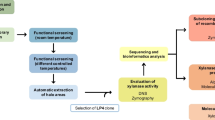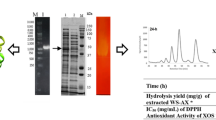Abstract
The production of xylitol from d-glucose occurs through a three-step process in which d-arabitol and d-xylulose are formed as the first and second intermediate product, respectively, and both are obtained via microbial bioconversion reactions. Catalytic hydrogenation of d-xylulose yields xylitol; however, it is contaminated with d-arabitol. The aim of this study was to increase the stereoselectivity of the d-xylulose reduction step by using enzymatic catalysis. Recombinant xylitol dehydrogenase from the yeast Galactocandida mastotermitis was employed to catalyze xylitol formation from d-xylulose in an NADH-dependent reaction, and coenzyme regeneration was achieved by means of formate dehydrogenase-catalyzed oxidation of formate into carbon dioxide. The xylitol yield from d-xylulose was close to 100%. Optimal productivity was found for initial coenzyme concentrations of between 0.5 and 0.75 mM. In the presence of 0.30 M (45 g/L) d-xylulose and 2000 U/L of both dehydrogenases, exhaustive substrate turnover was achieved typically in a 4-h reaction time. The enzymes were recovered after the reaction in yields of approx 90% by means of ultrafiltration and could be reused for up to six cycles of d-xylulose reduction. The advantages of incorporating the enzyme-catalyzed step in a process for producing xylitol from d-glucose are discussed, and strategies for downstream processing are proposed by which the observed coenzyme turnover number of approx 600 could be increased significantly.
Similar content being viewed by others
References
Parajo, J. C., Dominguez, H., and Dominguez, J. M. (1998), Bioresour. Technol. 65, 191–201.
Parajo, J. C., Dominguez, H., and Dominguez, J. M. (1998), Bioresour. Technol. 65, 203–212.
Parajo, J. C., Dominguez, H., and Dominguez, J. M. (1998), Bioresour. Technol. 66, 25–40.
Meinander, N. Q. and Hahn-Hägerdal, B. (1997), Biotechnol. Bioeng. 54, 391–399.
Roca, E., Meinander, N., and Hahn-Hägerdal, B. (1996), Biotechnol. Bioeng. 51, 317–326.
Onishi, H. and Suzuki, T. (1969), Appl. Microbiol. 18, 1031–1035.
Leleu, J. -B., Duflot, P., and Caboche, J. -J. (1993), US patent no. US005096820.
Wong, B., Murray, J. S., Castellanos, M., and Croen, K. D. (1993), J. Bacteriol. 175, 6314–6320.
Suzuki, S., Sugiyama, M., Mori, M., Mihara, Y., and Yokozeki, K. (2000), European patent no. EP1026255A1.
Sugiyama, M., Suzuki, S., Mihara, Y., Hashiguchi, K., and Yokozeki, K. (2000), European patent no. EP1026254A1.
Lunzer, R., Mamnun, Y., Haltrich, D., Kulbe, K. D., and Nidetzky, B. (1998), Biochem. J. 336, 91–99.
Lunzer, R., Ortner, I., Haltrich, D., Kulbe, K. D., and Nidetzky, B. (1998), Biocat. Biotrans. 16, 333–349.
Habenicht, A., Motejadded, H., Kiess, M., Wegerer, A., and Mattes, R. (1999), Biol. Chem. 380, 1405–1411.
Schütte, H., Flossdorf, J., Sahm, H., and Kula, M. -R. (1976), Eur. J. Biochem. 62, 155–160.
Slatner, M., Nidetzky, B., and Kulbe, K. D. (1999), Biochemistry 38, 10,489–10,498.
Nidetzky, B., Neuhauser, W., Haltrich, D., and Kulbe, K. D. (1996), Biotechnol. Bioeng. 52, 387–396.
Kragl, U., Vasic-Racki, D., and Wandrey, C. (1996), Bioprocess Eng. 14, 291–297.
Osawa, T., Harada, T., and Osamu, T. (2000), Top. Catal. 13, 155–168.
Mohr, T., Schwarz, E., and Mackert, P.-J. (2001), World patent no. W01/00550A1.
Makkee, M., Kieboom, A. P. G., and van Bekkum, H. (1985), Starch 37, 136–141.
Seelbach, K. and Kragl, U. (1997), Enzyme Microb. Technol. 20, 212–235.
Author information
Authors and Affiliations
Corresponding author
Rights and permissions
About this article
Cite this article
Mayer, G., Kulbe, K.D. & Nidetzky, B. Utilization of xylitol dehydrogenase in a combined microbial/enzymatic process for production of xylitol from d-glucose. Appl Biochem Biotechnol 98, 577–589 (2002). https://doi.org/10.1385/ABAB:98-100:1-9:577
Issue Date:
DOI: https://doi.org/10.1385/ABAB:98-100:1-9:577




